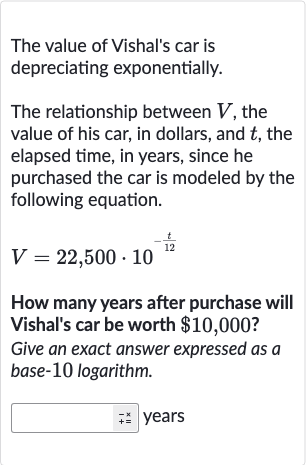AI tutor
Welcome to Bytelearn!
Let’s check out your problem:

The value of Vishal's car is depreciating exponentially.The relationship between , the value of his car, in dollars, and , the elapsed time, in years, since he purchased the car is modeled by the following equation.How many years after purchase will Vishal's car be worth ?Give an exact answer expressed as a base logarithm.years
Full solution
Q. The value of Vishal's car is depreciating exponentially.The relationship between , the value of his car, in dollars, and , the elapsed time, in years, since he purchased the car is modeled by the following equation.How many years after purchase will Vishal's car be worth ?Give an exact answer expressed as a base logarithm.years
- Set up equation: Set up the equation with the given value of the car.We are given the equation and we want to find the time when .So, we set up the equation .
- Divide sides: Divide both sides of the equation by to isolate the exponential term.This simplifies to .
- Convert to logarithmic form: Convert the equation to logarithmic form to solve for . We can take the base logarithm of both sides to get . Using the property of logarithms that , we get . Since is , this simplifies to .
- Solve for t: Solve for t.To isolate , we multiply both sides by : .
- Calculate exact value: Calculate the exact value of ..This is the exact answer expressed as a base- logarithm.
More problems from Convert between exponential and logarithmic form: rational bases
QuestionGet tutor help
